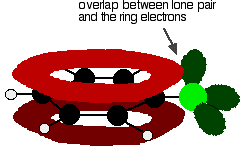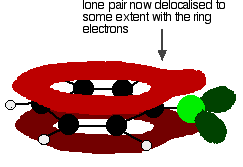7.16: Vinyl Halides and Aryl Halides
- Page ID
- 28182
Nucleophilic substitution in the aryl halides
We'll look in some detail at the structure of chlorobenzene. Bromobenzene and iodobenzene are just the same. The simplest way to draw the structure of chlorobenzene is:

To understand chlorobenzene properly, you need to dig a bit deeper than this. There is an interaction between the delocalised electrons in the benzene ring and one of the lone pairs on the chlorine atom. This overlaps with the delocalised ring electron system . . .

to giving a structure rather like this:

This delocalisation is by no means complete, but it does have a significant effect on the properties of both the carbon-chlorine bond and the polarity of the molecule. The delocalisation introduces some extra bonding between the carbon and the chlorine, making the bond stronger. This has a major effect on the reactions of compounds like chlorobenzene.
There is also some movement of electrons away from the chlorine towards the ring. Chlorine is quite electronegative and usually draws electrons in the carbon-chlorine bond towards itself. In this case, this is offset to some extent by the movement of electrons back towards the ring in the delocalisation. The molecule is less polar than you would otherwise have expected.
Simple aryl halides like chlorobenzene are very resistant to nucleophilic substitution. It is possible to replace the chlorine by -OH, but only under very severe industrial conditions - for example at 200°C and 200 atmospheres. In the lab, these reactions do not happen. There are two reasons for this - depending on which of the above mechanisms you are talking about.
- The extra strength of the carbon-halogen bond in aryl halides: The carbon-chlorine bond in chlorobenzene is stronger than you might expect. There is an interaction between one of the lone pairs on the chlorine atom and the delocalized ring electrons, and this strengthens the bond. Both of the mechanisms above involve breaking the carbon-halogen bond at some stage. The more difficult it is to break, the slower the reaction will be.
- Repulsion by the ring electrons: This will only apply if the hydroxide ion attacked the chlorobenzene by a mechanism like the first one described above. In that mechanism, the hydroxide ion attacks the slightly positive carbon that the halogen atom is attached to.If the halogen atom is attached to a benzene ring, the incoming hydroxide ion is going to be faced with the delocalized ring electrons above and below that carbon atom. The negative hydroxide ion will simply be repelled.
Contributors
Jim Clark (Chemguide.co.uk)


